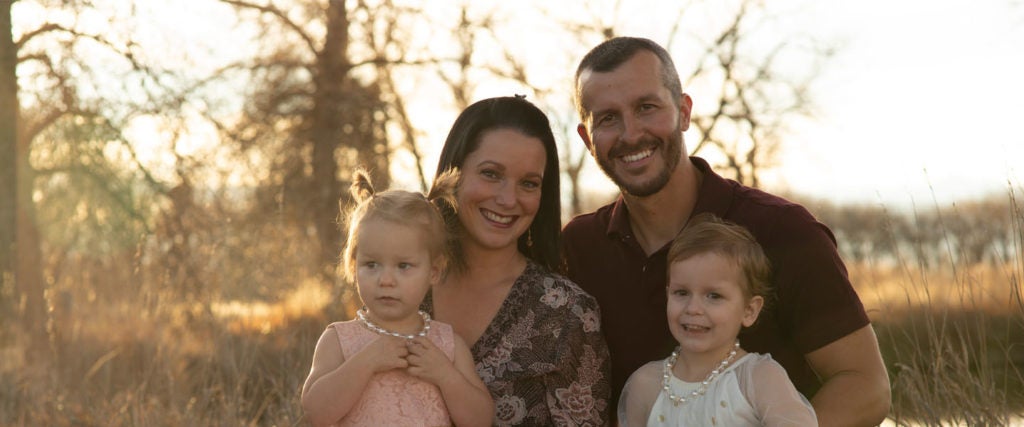As riveting as they can be, I’ve always had reservations about true-crime series. There’s something inherently ghoulish in watching a documentary about something terrible that happened to someone you’ve never met. A random person’s murder is turned into entertainment for the rest of us, complete with dramatic music and shocking twists. Even the best of the genre still invite the viewer to exhume the misery of real people from the comfort of your couch. But the hope is that the dark dive into humanity’s worst tendencies can at least glean insights into why such horrible crimes occur, as well as shed light on what it says about us as a society. At least that’s what I tell myself.
The Netflix documentary American Murder: The Family Next Door takes the genre in a new direction, one that I can imagine might become very popular but left me enraged. Telling the story of the 2018 murder of Shanann Watts and her two daughters, director Jenny Popplewell has crafted her film entirely from preexisting materials, essentially creating a found-footage true-crime documentary. There are good reasons to adopt this approach — for one thing, it presents Watts and her husband Chris (who killed Shanann and their girls) as real people, speaking in their own words — but I walked away from American Murder deeply uncomfortable. The movie feels like vulturing through the dead’s personal effects without reaping much wisdom from the process. So why do it?
“All materials in this film were captured by police, media or uploaded to the internet,” an opening title card informs us. “Personal footage and messages were also provided by Shanann’s family and friends.” American Murder benefits greatly from the fact that Shanann, who died at the age of 34, often recorded video messages onto Facebook, sharing her thoughts and updates with her friends and family. Since the film features no voiceover or talking-head interviews, she becomes our unlikely narrator, telling us about how she’d lost confidence in herself after enduring a bad marriage and a lupus diagnosis. That’s when she met Chris, an unassuming sweetheart who was patient with her as she tried to scare him away. (After her divorce, she wasn’t sure she wanted another relationship.) But love won out, and by 2018, they’d been together about eight years and married for six, giving birth to daughters Bella and CeCe, with a son on the way.
Then, in August, Shanann went missing. The police arrived at the Watts household in Colorado after a friend of Shanann’s got worried because she hadn’t heard from her, and we watch bodycam footage as Chris anxiously wonders where his wife and girls could be. Did she take their daughters and run off? Were they kidnapped? Other true-crime films might recreate these moments with actors or have the officers recount what they saw when they arrived. American Murder shows us the actual events, as well as the subsequent polygraph and interrogation of Chris once it becomes clear that he knows more about the women’s disappearance than he’s letting on.
American Murder has clearly been made with the blessing of Shanann’s family, who are thanked in the end credits. (Her family spoke out earlier this year to condemn an unauthorized Lifetime docudrama about the killings.) But from its salacious title to some of its structural choices, the film nonetheless comes across as sensational and rubberneck-y, letting us eavesdrop on the private text conversations between Shanann and Chris in the weeks leading up to her murder. As we’ll learn, Shanann became concerned that her usually loving husband had grown distant — he’d stopped being physically affectionate — and worried that he might be having an affair. We see her texts pop up on screen as if they’re being typed out right now. (To amplify the sense that this is all happening in real time, a word or phrase will sometimes be deleted and then retyped as she tries to get Chris to open up or complains to a friend about her marriage.) We’re reading some of the final correspondences from a slain woman.
Popplewell ends her film with a card noting that, “In America three women are killed by their current or ex partner every day,” and presumably American Murder’s excavation of these private communications, Facebook posts and home movies is meant to illustrate the despairing commonness of these unconscionable crimes. Outwardly, the Wattses seemed like a happy couple with two adorable young girls, and yet their story ended in violent tragedy. But while the footage is intimate, I’m not convinced it’s particularly illuminating — I’m not sure I actually learned anything by getting this up-close-and-personal account of Shanann’s life. You could make the argument that perhaps that’s the point — there’s no simple explanation for how Chris became a murderer — but even so, discovering that Shanann was sexually frustrated or that Chris sometimes felt badgered by her nitpicking seems entirely unrevealing. It’s trivia presented as worthwhile information — or, worse, juicy tidbits.

Eventually, American Murder begins jumping back and forth between the search for Shanann and her girls (which leads to Chris’ arrest and trial) and flashbacks to earlier in their marriage. Because of its found-footage construction, the film could be construed as a commentary on our online selves. It’s a sad fact, although often forgotten, that people’s social-media lives don’t accurately reflect their real lives. On Instagram, we show off the beautiful or exciting aspects of our world, but the quiet desperation never sees the light of day. If you just looked at Shanann’s social-media pages, you’d assume everything was great. The ugly truth wasn’t something she shared on Facebook.
Interestingly, in recent years Hollywood has experimented with found-footage online films — for example, the horror movie Unfriended and the John Cho thriller Searching — and it’s striking how these fictional stories offer more compelling studies of this jarring contrast between our “real” selves and our virtual ones than American Murder. In Unfriended and Searching, we watch the characters entirely through their digital presence, the movies building suspense around our obsessive online chronicling, hitting upon a crucial paradox: We seem more connected, and yet we’re profoundly not as tapped into each other’s lives. It’s eerie how easily we disregard that the avatars on our phone and computer screens are actually flesh-and-blood humans — in a sense, we’ve forgotten that they’re real.
Unfortunately, although American Murder is about actual victims, not movie characters, Popplewell and editor Simon Barker don’t add much new to these ideas about our virtual selves. It’s undeniably riveting to watch Chris initially walk into the police station confident in his lies, only to slowly unravel once he fails his polygraph. (A female detective is especially captivating, first pretending to be his smiling buddy before eventually grilling him.) We see how actual police questioning differs from what we see on cop shows. But those rare glimpses of unfettered real life are overwhelmed by the filmmakers’ desire to provide a narrative spine that retells this sad tale through archival news coverage and various online clips. (And, of course, there need to be plot twists. It turns out that Chris did, indeed, have a mistress. She’s introduced in American Murder in a way I found insulting, playing up her attractiveness so that she’s presented as an evil homewrecker before she’s even allowed to speak.)
Anyone who watches American Murder will be heartbroken for Shanann, as well as her young daughters and their mourning family members. But rather than peeling away the digital representation of Shanann — the happy face we meet on Facebook — to give us a sense of the actual person, the film stays on the surface. It’s a dark truth of our social-media age: What we see online from our loved ones isn’t the whole story. But for all the supposed candor of private texts and public Facebook posts, Shanann and her marriage remain a frustrating mystery.
At only about 85 minutes, the film doesn’t pretend to be a definitive portrait, and I don’t doubt its makers’ honorable, heartfelt intentions. But in its pursuit of offering us the unfiltered intimacy of a marriage as it was falling apart, American Murder in some ways cheapens the seriousness of its purpose. The movie doesn’t bring Shanann Watts back to life so much as it invites us to scroll through her online remnants. American Murder wants to sound an alarm about domestic violence, but the film has little to say about why these crimes happen or what the warning signs are. I ended up feeling doubly horrible for Shanann and her girls — first because of what happened to them and second for the way their lives are put on display in this documentary. There aren’t revelations here — only the grim reminder that there’s an audience that will eagerly log on to soak it up.

